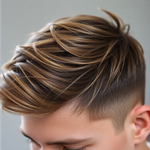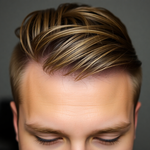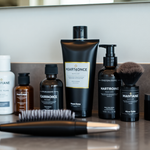
Minimal Risk, Maximum Cohesion: Use Semi-Permanent Hair Color to Unite Your Sustainable Men's Capsule Wardrobe
21 August 2025
Share
Semi-permanent hair color is the low-risk tweak men need to pull a capsule wardrobe together—fast.
Struggling to look intentional without buying more clothes? Semi-permanent hair color can be the easiest, most sustainable shortcut to greater visual cohesion in your capsule wardrobe. With minimal commitment and less chemical stress than permanent dyes, this simple change fixes contrast problems, harmonizes skin and fabric tones, and reduces impulse buys. Read on for the full how-to: shade rules, application steps, maintenance plans, seasonal adjustments, and real-world styling combos that work for men aged 18–45.
Semi-Permanent Hair Color: The Low-Risk Upgrade for Your Capsule Wardrobe
Think of a capsule wardrobe as a short playlist of tracks that always sound good together. Semi-permanent hair color is the mixing engineer: it smooths clashing notes and boosts the tracks you want to hear. Because semi-permanent color fades gradually and usually avoids high-peroxide developers, it fits a sustainable mindset—fewer fixes, fewer products, and less time in the salon chair. That equals less money spent and more consistent style.
Why hair tone matters for capsule cohesion
- Contrast control: Hair that’s too light against a deep navy coat can make your face look washed out. Darkening slightly tightens the silhouette and brightens facial features.
- Undertone harmony: Warm hair tones pair best with warm fabrics (camel, olive, rust). Cool hair tones suit cool palettes (navy, charcoal, black).
- Signature look: Subtle, repeatable hair tone helps you feel unified across outfits, photos, and professional settings without buying new pieces.
Who benefits most? (Spoiler: Nearly everyone)
This approach suits multiple audience segments:
- Young professionals: Need sharper headshots and a consistent office look without frequent salon visits.
- Students and creatives: Want to tune their personal brand affordably and sustainably.
- Fitness-focused guys: Prefer low-maintenance grooming that survives sweaty routines.
- Budget-conscious shoppers: Reduce impulse buys by fixing visual tension with hair tone rather than new clothes.
Step-by-step: How to choose a shade that pulls outfits together
- Audit the core pieces: Lay out 8–12 items you wear most. Note dominant colors and undertones (warm, cool, neutral).
- Pick the priority conflict: Is your hair making shirts look dull? Or does your jacket wash your face out? Pick one recurring issue to solve.
- Choose undertone over exact level: Match the hair undertone to your wardrobe. If your clothes are mostly cool, look for cool ash browns. For warm palettes, target chestnut or caramel tones.
- Stick to small changes: For a capsule wardrobe, adjust 1–2 levels from your natural shade. Subtlety is cohesive; dramatic shifts break the low-key look.
- Do a strand test: Apply to a discreet section, follow the timing instructions, rinse, and check in daylight. This is the single most important risk reduction step.
Application guide: At-home or pro—what to expect
Whether you go DIY or book a short salon visit, the process is straightforward.
- At-home kit: Follow instructions exactly. Use gloves, apply to dry hair, work through lengths, and avoid saturating the scalp. Rinse at the earliest recommended time if the result looks intense.
- Salon: Book a consult and bring photos of outfits and the capsule you want to complement. Ask the stylist for a demi-permanent or semi-permanent formula and a natural-looking blend.
- Timing: Semi-permanent color usually takes 20–45 minutes depending on the product and desired depth.
Do’s and don’ts for a clean, masculine result
- Do choose matte, natural-looking shades rather than glossy, fashion tones unless that’s the goal.
- Do blend roots into lengths for a lived-in, low-maintenance finish.
- Don’t try to go several shades lighter with semi-permanent color; it won’t lift natural pigment—only deposit tone.
- Don’t ignore a patch test—sensitivity reactions are rare but real.
Maintenance plan: Stretch color, save money, and limit waste
Minimal maintenance keeps your look consistent while supporting sustainability goals.
- Wash smart: Use cool water and a sulfate-free, color-safe shampoo 2–3 times a week to keep the color from fading fast.
- Condition: Apply a weekly deep conditioner or a leave-in detangler to protect hair fiber and extend color life.
- Space refreshes: Plan touch-ups every 6–10 weeks rather than monthly. Semi-permanent color fades gracefully, so you can live with softer contrast longer.
- Eco swaps: Choose refillable or minimal-packaging products and recycle applicators where local rules allow.
Color theory cheat sheet for men
Use this quick reference when you pick shades.
- Cool wardrobes (navy, slate, black): Ash browns, cool espresso tones, and neutral blacks.
- Warm wardrobes (camel, olive, rust): Warm chestnuts, golden browns, and soft caramel highlights.
- Neutral or mixed wardrobes: Mid-tone brown with neutral undertones works best; avoid extremes.
Styling combos: Match hair tone to outfits for maximum cohesion
Pairing ideas that are easy to test in the morning.
- The sharp office kit: Dark ash hair + navy blazer + white shirt + dark denim. Result: head-to-jacket contrast that reads professional in photos and meetings.
- The relaxed weekend: Warm chestnut hair + olive utility jacket + cream tee + chinos. Result: earthy cohesion that looks intentional rather than forced.
- The date-night uniform: Mid-tone brown hair + charcoal leather jacket + black tee. Result: softer facial contrast that feels approachable and confident.
Seasonal adjustments: How to shift tone without overcommitting
- Spring/Summer: Slightly warmer, lighter deposits (caramel or warm brown) reflect sunlit seasons and pair well with light knits and tees.
- Fall/Winter: Richer, deeper tones (espresso, deep chestnut) anchor heavier outerwear and layered looks.
- Transition approach: Use semi-permanent color in small tweaks—add warm tonal deposits in late spring and let them mellow into fall.
Troubleshooting: Common problems and simple fixes
- Too warm: Use a clarifying shampoo once, then re-tone with a cooler semi-permanent shade if needed.
- Too dark: Semi-permanent color fades with washes; use gentle clarifying treatments and wait 2–4 weeks before reapplying.
- Uneven results: Next time apply in thinner sections and use a comb to distribute. A stylist can also blend with lowlights or glosses.
Safety and sustainability: What to check before you buy
Pay attention to ingredients and certifications. Semi-permanent formulas typically avoid ammonia and use lower levels of peroxide. Still, always read labels and consider the following:
- Look for brands that publish full ingredient lists and sustainability claims.
- Avoid unnecessary single-use plastic where possible; seek refill programs or minimal packaging.
- Do a patch test 48 hours before full application to rule out sensitivities.
For a trustworthy primer on hair-dye safety and possible reactions, check this WebMD resource on hair-color facts and safety considerations: WebMD: Hair Dye Facts.
Tools and product picks
- At-home kit essentials: Gloves, tint brush, bowl, sectioning clips, and a color-safe shampoo.
- Salon suggestions: Ask for demi- or semi-permanent formulas, a blending technique, and a plan for low-maintenance upkeep.
- Style pairings: Menll.com’s pieces are crafted with sustainability in mind and work well with deeper, cleaner hair tones—see Menll.com’s outerwear to pair with a darker or cooler hair shade: Menll.com Outerwear.
- More capsule tips: If you’re building or refining your capsule, this Menll.com guide on building a capsule wardrobe is a solid next read: How to Build a Capsule Wardrobe.
Case studies: Small changes, big payoff
Real setups that show how subtle tone shifts can change perception.
- The consultant: Mid-30s, pale skin, mostly navy suits. Problem: outfits looked flat on camera. Solution: a semi-permanent ash-brown deposit deepened hair slightly and improved contrast in headshots. Result: more confidence in meetings and fewer new shirt purchases.
- The grad student: Early 20s, mixed capsule of warm neutrals. Problem: light hair clashed with warm sweaters. Solution: soft chestnut deposit to add warmth. Result: outfits felt curated and less budget-strained.
- The gym-first guy: Late 20s, simple wardrobe, wants low-maintenance grooming. Problem: frequent shampooing faded color fast. Solution: cooler, mid-tone shade with a sulfate-free routine and weekly conditioning. Result: minimal upkeep and a consistent look through workouts and weekends.
FAQs
- How long does semi-permanent color last? Usually 4–12 weeks depending on hair porosity, wash frequency, and product quality.
- Can I go from light to dark? Yes—depositing darker tones is the easiest move with semi-permanent color.
- Can it cover gray? Semi-permanent color can blend gray but may not fully cover very resistant gray hairs; multiple applications or demi-permanent options may be needed.
- Will it damage my hair? Less than permanent dye. Choose conditioning formulations and avoid overlapping heavy chemical processes.
Final checklist before you start
- Review your capsule and note 3 outfits you want to improve.
- Pick an undertone and a subtle level change (1–2 levels).
- Buy a color with clear ingredient information and a color-safe shampoo.
- Do a strand and patch test 48 hours before full application.
- Plan a maintenance cadence that fits your lifestyle and sustainability goals.
Wrap-up: Minimal risk, maximum cohesion
Small, intentional changes beat constant shopping. Semi-permanent hair color gives you a low-risk, high-impact tool to bring a sustainable men's capsule wardrobe into visual harmony. You get fewer impulse buys, easier upkeep, and a signature look that reads consistent and confident—without harsh chemicals or constant salon trips.
What outfit in your capsule would you try this with first? Share your go-to capsule trick in the comments or explore Menll.com’s capsule-ready pieces and outerwear to pair with your new look: Menll.com.
Prev post

Cut Decision Fatigue: How Semi‑Permanent Hair Color Pairs with a Minimalist, Sustainable Men's Wardrobe
Updated on 23 August 2025
Next post

Shade Strategy: How Semi-Permanent Hair Color Simplifies Outfit Choices for the Eco-Conscious Man
Updated on 20 August 2025





